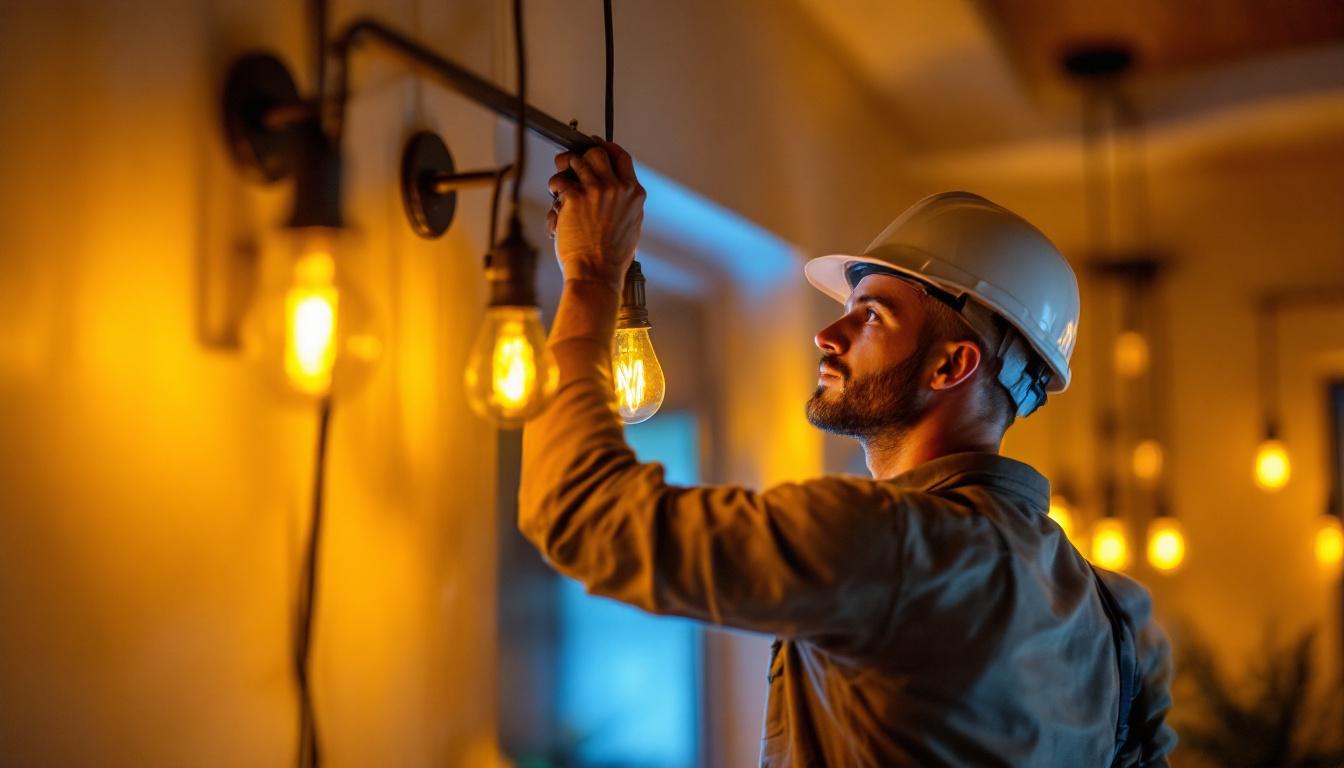
Lighting plays a crucial role in enhancing the aesthetics and functionality of any space. Among the various lighting options available, amber color light has gained significant popularity for its warm and inviting ambiance. However, for lighting contractors, understanding the nuances of amber lighting is essential to ensure optimal results for their clients. This article outlines the do’s and don’ts when working with amber color light, providing valuable insights for lighting professionals.
Amber color light is often associated with warmth and comfort. It creates a cozy atmosphere that can transform a space, making it feel more welcoming. This type of lighting is particularly effective in residential settings, restaurants, and hospitality venues where creating an inviting environment is paramount. The soft glow of amber light can soften the harshness of a room, making it an ideal choice for spaces where relaxation is key. This is why many interior designers advocate for the use of amber lighting in areas meant for social interaction, as it encourages conversation and connection among individuals.
Moreover, amber light has been shown to reduce eye strain compared to harsher white lights. This characteristic makes it an excellent choice for spaces where people spend extended periods, such as offices and living rooms. Additionally, amber lighting can enhance the colors of various materials, making them appear richer and more vibrant. The warm tones of amber can highlight wooden furniture and textiles, creating a harmonious and inviting aesthetic. This quality also makes amber light a popular choice in art galleries and museums, where it can beautifully illuminate artworks without causing damage or distortion.
When used strategically, amber color light can significantly enhance the ambiance of a space. It can evoke feelings of relaxation and tranquility, making it an ideal choice for areas designated for leisure, such as lounges and bedrooms. Lighting contractors should consider the intended use of the space when selecting amber lighting fixtures. The versatility of amber light allows it to be paired with various design elements, from rustic to modern, ensuring that it complements the overall decor while enhancing the mood.
For instance, in a dining area, warm amber lighting can create a romantic atmosphere, encouraging patrons to linger and enjoy their meals. The gentle illumination helps to create a sense of intimacy, making the dining experience more memorable. In contrast, in a workspace, a softer amber light can help reduce stress levels, promoting productivity without overwhelming the senses. Furthermore, the calming effect of amber light can aid in concentration, making it a preferred choice for study areas and creative spaces where focus is essential. By adjusting the intensity and placement of amber lighting, one can tailor the environment to suit various activities and moods.
Another advantage of amber color light is its energy efficiency. LED technology has made it possible to produce amber light with minimal energy consumption. Lighting contractors should advocate for the use of LED amber fixtures to their clients, highlighting the long-term cost savings and environmental benefits. These energy-efficient bulbs not only consume less power but also have a longer lifespan compared to traditional incandescent bulbs, reducing the frequency of replacements and waste.
Additionally, energy-efficient lighting solutions can contribute to LEED certification for commercial projects. By incorporating amber LED lights, contractors can help their clients achieve sustainability goals while also enhancing the aesthetic appeal of their spaces. The use of amber lighting can also play a role in reducing light pollution, as it tends to emit less blue light, which can disrupt natural ecosystems and human circadian rhythms. This makes amber lighting a thoughtful choice for outdoor applications, such as street lamps and garden lighting, where a softer glow is preferred to maintain the tranquility of the environment. As communities become more aware of the impact of lighting on both health and the environment, the demand for amber lighting solutions is likely to grow, making it a smart investment for the future.
When working with amber color light, there are several best practices that lighting contractors should follow to ensure successful implementation. These guidelines can help maximize the benefits of amber lighting while avoiding common pitfalls.
Before selecting amber lighting fixtures, it is crucial to assess the space thoroughly. Factors such as the size of the area, the existing color palette, and the intended use should all be considered. For example, a small room with dark walls may require brighter amber lights to achieve the desired effect, while a larger space may benefit from a combination of ambient and accent lighting.
Additionally, understanding the natural light sources in the area can help determine the appropriate intensity and placement of amber lights. This assessment will ensure that the lighting complements the overall design and functionality of the space.
Amber lighting comes in various fixtures, including pendant lights, wall sconces, and recessed lighting. Each type of fixture can produce different effects, so it is essential to experiment with different options to find the best fit for the project. For instance, pendant lights can create a focal point in a dining area, while wall sconces can provide subtle illumination in hallways or entryways.
Moreover, using dimmable amber lights allows for greater flexibility in adjusting the ambiance as needed. This feature is particularly beneficial in multi-purpose spaces where the lighting requirements may change throughout the day.
Amber color light is often associated with a specific color temperature, typically ranging from 2200K to 3000K. However, it is essential to consider the color temperature in relation to the overall design scheme. Warmer temperatures can create a more intimate atmosphere, while slightly cooler amber tones can provide a more modern feel.
Lighting contractors should communicate with their clients about the desired mood and aesthetic to ensure the chosen color temperature aligns with their vision. Providing samples or mock-ups can help clients visualize the final result, leading to more informed decisions.
While there are many do’s to follow, there are also common mistakes that lighting contractors should avoid when working with amber color light. Understanding these pitfalls can help ensure a successful project outcome.
One of the most significant mistakes contractors can make is overdoing the amber lighting. While amber light can create a warm and inviting atmosphere, too much can lead to a space feeling overly dim or even claustrophobic. It is essential to strike a balance between ambient, task, and accent lighting to achieve the desired effect without overwhelming the space.
Contractors should also be cautious about the placement of fixtures. Overlapping light sources can create harsh shadows or uneven illumination, detracting from the overall aesthetic. A well-thought-out lighting plan that considers the interplay of different light sources is crucial.
The colors of the walls, furniture, and decor in a space can significantly influence how amber light is perceived. Lighting contractors should avoid selecting amber fixtures without considering the surrounding colors. For instance, amber light can enhance warm tones like reds and yellows, while it may clash with cooler tones like blues and greens.
To ensure a harmonious design, it may be beneficial to test the amber light against the existing colors in the space. This approach can help identify any potential clashes and allow for adjustments before installation.
Amber lighting fixtures, like any other lighting solution, require regular maintenance to ensure optimal performance. Dust and dirt can accumulate on fixtures, reducing their effectiveness and altering the quality of light. Lighting contractors should educate their clients on the importance of maintaining their amber lighting systems.
Additionally, it is essential to recommend high-quality fixtures that are durable and easy to clean. This consideration can help reduce maintenance issues and enhance the longevity of the lighting system, ultimately benefiting both the contractor and the client.
As the demand for amber color light continues to grow, several trends have emerged in the lighting industry. Staying informed about these trends can help contractors offer innovative solutions to their clients.
Smart lighting technology has revolutionized the way people interact with their lighting systems. Many manufacturers now offer smart amber LED fixtures that can be controlled via smartphone apps or voice commands. This technology allows users to adjust brightness, color temperature, and even create lighting schedules.
Lighting contractors should consider incorporating smart lighting solutions into their projects, as they offer added convenience and energy efficiency. Educating clients on the benefits of smart lighting can also enhance their overall satisfaction with the installation.
Layered lighting designs have become increasingly popular, allowing for greater flexibility and customization in lighting schemes. By combining ambient, task, and accent lighting, contractors can create a dynamic environment that adapts to various activities and moods.
Incorporating amber lighting into a layered design can enhance the overall effect, providing warmth and depth to the space. Contractors should encourage clients to consider how different lighting layers can work together to achieve their desired ambiance.
As sustainability becomes a priority for many consumers, eco-friendly lighting options are gaining traction. Contractors should stay informed about the latest advancements in energy-efficient amber lighting solutions, such as solar-powered fixtures and recyclable materials.
Promoting eco-friendly options can not only attract environmentally conscious clients but also contribute to a more sustainable future for the lighting industry. Highlighting the benefits of these options can set a contractor apart from the competition.
Amber color light offers a unique opportunity for lighting contractors to create warm and inviting spaces that enhance the overall experience for occupants. By following the do’s and don’ts outlined in this article, contractors can ensure successful implementations that meet their clients’ needs and preferences.
From assessing the space and experimenting with different fixtures to avoiding common pitfalls and staying informed about industry trends, lighting contractors have the tools to excel in their projects. Embracing amber lighting can lead to stunning results, making a lasting impact on both residential and commercial environments.
Ultimately, the key to success lies in understanding the nuances of amber color light and applying that knowledge to create beautiful, functional, and sustainable lighting solutions.
Ready to bring the warm, inviting glow of amber color light to your next project? At LumenWholesale, we provide lighting contractors with the highest quality, spec-grade lighting products at prices that can’t be beaten. Say goodbye to middleman markups and hello to a vast selection of reliable lighting solutions that meet rigorous industry standards. With the added convenience of free shipping on bulk orders, you can trust that you’re getting premium lighting at the best value. Enhance your lighting installations with the perfect blend of quality, affordability, and convenience. Wholesale Lighting at the Best Value is just a click away. Experience the LumenWholesale difference today!

Discover how different lamp bulb base types can significantly influence the success of lighting contractors’ projects.

Explore the revolutionary journey of the light bulb’s invention and its transformative impact on the lighting industry.

Discover essential insights on washer machine plug adapters tailored for lighting contractors.

Discover expert advice for lighting contractors on harnessing the power of solar-powered LED lights with 1000 lumens.